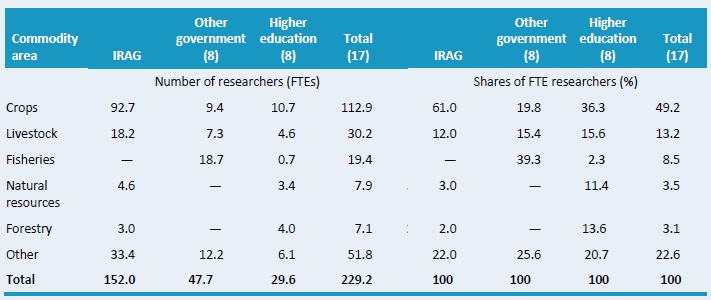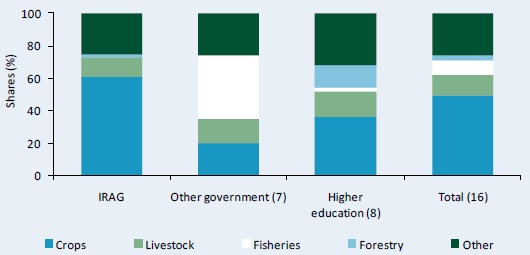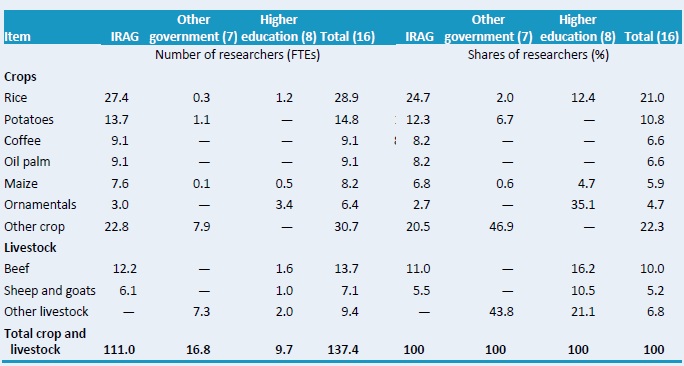The ASTI Data in Focus series provides additional background data in support of the 2010 Country Note on Guinea (asti.cgiar.org/pdf/Guinea-Note.pdf) prepared by the Agricultural Science and Technology Indicators (ASTI) initiative and the Guinean Agricultural Research Institute (IRAG). Based on data collected by ASTI and IRAG, these two outputs review major investment and capacity trends in Guinea's public agricultural research and development (R&D) since 1991, providing important updates on agricultural R&D trends prepared by ASTI and IRAG in 2003–04.
D. Research Allocation across Commodities and Themes
This section provides detailed quantitative information on Guinea's public agricultural research allocation for 2008. Complementary sections present detailed data on long-term trends (Section A), financial resources (Section B), and human resources (Section C). Further supporting information provides macroeconomic trends, a list of agencies included in the study, data sources and estimation procedures, and ASTI's methodology.
Table D1–Research focus by major commodity area, 2008
This table presents researcher numbers by major commodity area, both in absolute and relative terms. In 2008, 133 of Guinea's 229 FTE researchers performed crop research. Thirty FTEs focused on livestock, 19 on fisheries, 8 on natural resources, and 7 on forestry issues. The remaining 52 FTEs concentrated on socioeconomic research or other matters. The share of crop research was highest at IRAG. Fisheries research was mostly carried out by other government agencies, whereas forestry research was mostly conducted in the higher education sector.

Source: Calculated by authors from IFPRI–IRAG 2009.
Note: Figures in parentheses indicate the number of agencies in each category.
Figure D1–Research focus by major commodity area, 2008
This figure presents data on the allocation of FTE researchers across commodity areas. In 2008, close to half of Guinea's 229 agricultural FTEs for whom data were available conducted crop research. Livestock research occupied 13 percent of all FTEs, whereas forestry and natural resources research each accounted for 3 percent.

Source : Calculated by authors from IFPRI–IRAG 2009.
Note: Figures in parentheses indicate the number of agencies in each category.
Table D2–Focus of crop and livestock research by major item, 2008
Rice was the most researched crop in Guinea in 2008, accounting for 21 percent of the FTE researchers involved in crop and livestock research. Other important crops included potatoes, coffee, palm oil, corn, and ornamental plants. The Guinean government overtly prioritizes research on food crops over export crops due to the importance of food security. The country's livestock researchers primarily focus on beef, sheep, and goats.

Source: Calculated by authors from IFPRI–IRAG 2009.
Note: Figures in parentheses indicate the number of agencies in each category.
Copyright (C) 2011 International Food Policy Research Institute (IFPRI) and Guinean Agricultural Research Institute (IRAG). Sections of this Data in Focus issue may be reproduced without the express permission of, but with acknowledgement to IFPRI and IRAG. This series is an output of the ASTI initiative and has not been peer reviewed. Any opinions stated herein are those of ASTI and do not necessarily reflect the policies and opinions of IFPRI or IRAG.
